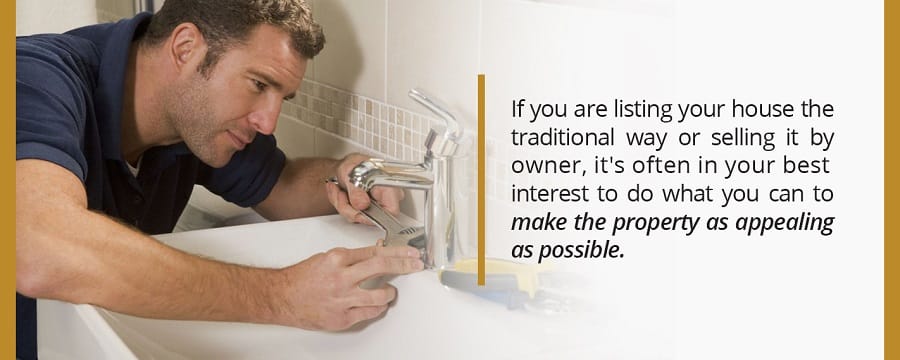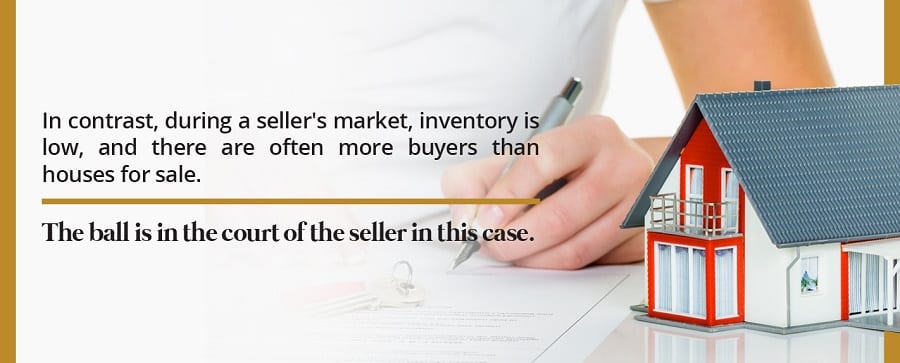
Your home has served you well over the years. It might be where you raised your family or the first significant purchase you made. But the time has come to move on — either to a bigger home to accommodate a growing family or a smaller place now that your children have grown up.
Before you sell, you’ll want to ensure your home is in the best condition possible so it appeals to buyers. However, you’ll also want to monitor your bottom line. You don’t want to invest more than you stand to recoup.
If you’re wondering what to fix up or if you should renovate before selling, the answer is yes — in some cases. Before jumping into any major renovations, it helps to know what improvements deliver the best return on investment (ROI). Understanding your selling options will also help you decide whether to make repairs and how much work to do before selling your house.
Table of Contents
What Is the Average Cost of Fixing Up a House to Sell It?
The average homeowner can expect to spend around $30,000 to remodel their home. Preparation costs could include improvement projects, staging costs and hidden fees. While this number might seem daunting, many sellers also sell above the listing price after making renovations, helping them get a return on their investments.
Is it worth renovating a house before selling it? How much should you spend preparing a house for sale? It’s possible to keep spending within budget when preparing your home for buyers. Some investments are costlier than others, like remodels. These investments are usually unnecessary — unless you intend to enjoy them personally before moving.
For example, if you intend to live in your home for the next five to 10 years, then perhaps a remodel is a good investment. However, if you don’t intend to enjoy these renovations, perhaps minor cosmetic updates, lawn care or staging costs are better investments.
The amount someone spends on fixing up their home also depends on how much work the home needs and the seller’s location. Sellers should focus on identifying the most cost-effective renovations for their circumstances that yield the best return on investment.
Cost vs. Value: Which Home Improvements Offer the Highest ROI?

When deciding what features of your home to upgrade, your mind might first go to the most eye-catching and attention-grabbing renovations possible. While remodeling the most noticeable and in-demand rooms in your house, like the kitchen and bathroom, might have a sizeable return on investment, you might be surprised to learn that less noticeable improvements typically provide the highest ROI.
Take a look at what you can expect to recoup from the following improvements in the Greater Kansas City area and across the U.S.
1. Siding Replacement
When was the last time you thought about the siding on your house? If it’s been a while, you might be surprised to learn that upgrading and replacing your home’s siding can lead deliver a considerable ROI. In the Greater Kansas City metro area, the AVERAGE COST TO REPLACE 1,250 SQUARE FEET OF SIDING IS $17,120. The resale value is $15,651, meaning the typical homeowner can recoup around 91 percent of their initial investment. The ROI of siding replacement in Kansas City and the surrounding area is slightly higher than the national average, which is 75 percent.
Another siding-related upgrade with a considerable ROI is replacing vinyl siding with manufactured stone veneer. Replacing 300 square feet of vinyl siding with stone veneer on the front of the house has an average cost of $9,312 in the greater Kansas City area and an ROI of around 85 percent. Adding stone veneer in Kansas City produces a smaller ROI compared to the national average, which is closer to 95 percent.
2. Garage Upgrades
In some cases, what seem like small improvements to a house can have a considerable impact on its resale value. Replacing a garage door has one of the highest ROIs nationally. The average cost of the replacement across the U.S. is $3,611 and translates to a resale value of $3,520, or an ROI of around 97 percent.
In the Kansas City metro area, the ROI on replacing a garage door is lower, at 78 percent.
3. Roof Replacement
The roof of a house might not be the feature people think about the most when they’re looking at properties. But it is a feature that plays an essential role in keeping residents dry and comfortable. A leaking roof or a roof that has other issues can be a deal-breaker in many home sales. Although replacing an older roof doesn’t have the ROI of replacing siding or a garage door, it does make a home more attractive to many buyers and does have a relatively high resale value.
In the Kansas City area, it costs an average of $24,409 to replace an asphalt roof. The average ROI is 65 percent. Metal roofs tend to have a higher price, around $41,000 in Kansas City and the surrounding area, but don’t produce the same ROI as an asphalt roof replacement. The typical resale value of a metal roof is about $24,000 or less than 60 percent of the cost of the replacement.
4. Kitchen Remodels
For many buyers, the kitchen is the most essential room in a house. People look for kitchens that are functional as well as attractive. Before you decide to upgrade your Formica countertops and to swap out your ivory or avocado-green appliances for shiny stainless upgrades, it’s important to understand just how much a kitchen remodeling project can deliver when it comes to ROI.
It might surprise you to learn that smaller projects often provide a higher ROI compared to major overhauls. A “mid-range” kitchen remodel has an average ROI of 82 percent. Meanwhile, an “upscale” kitchen remodel has an ROI of around 59 percent in the Kansas City metro area. Nationwide, the numbers are similar. A minor remodel has an ROI of about 81 percent, while an upscale major remodel has an ROI of about 60 percent.
If you are going to remodel or renovate your kitchen, keeping a few things in mind can help you get the best possible return and can help you avoid spending more than the remodel will end up being worth. One thing to do is use the value of your house to figure out how much to spend on a remodel.
A standard recommendation is to spend NO MORE THAN 15 PERCENT of the value of your home on your kitchen project. If your home is worth $200,000, your kitchen renovation budget should be less than $30,000. Setting a cap for your project will help you recoup as much as possible without breaking the bank in the meantime.
5. Bathroom Remodels
After the kitchen, the bathrooms in a house are the rooms that can make or break a home sale. If a house doesn’t have enough bathrooms, a buyer is likely to walk away. If the bathrooms in the house are outdated or otherwise unappealing, that can also turn off potential buyers.
In some cases, making a few small improvements to an existing bathroom can provide the best ROI. If the bathroom is in good working order, recaulking the tile and replacing fixtures and handles might be all that’s needed to make it a more attractive space. If you decide to do a major renovation or remodel of your bathroom, sticking with the “mid-range” rather than going upscale can help you get a better return on investment.
In the Kansas City metro area, mid-range bathroom renovations typically recouped around 67 percent of the cost while upscale renovations often recouped about 63 percent of the price. If the number of bathrooms in your house is limited, it might be a smart choice to add one before you decide to sell. The average mid-range bathroom addition in the Kansas City area costs around $50,000 and recoups about 65 percent of the cost.
More importantly, adding a bathroom can be what gets your home to sell. If buyers don’t think a house has enough bathrooms for their needs, they’re going to look elsewhere.
6. Window Replacement
The windows in your home let light in and provide a view to the surrounding neighborhood, but they also help to keep your home insulated, warm in the winter and cool in the summer. Older windows often don’t have the insulating abilities of newer ones. For that reason, replacing the windows of your home before you sell can be a smart move.
Window replacement projects also typically have a good return on investment. Nationwide, homeowners often recoup between 70 and 73 percent of the cost to replace their windows while in the greater Kansas City area, homeowners can expect to recover around 65 to 69 percent of the cost of the replacement, depending on whether they replaced wood or vinyl windows.
Which Renovations Are Worth It?
From kitchen and bathroom remodels to window and garage door replacements, there are many ways you can update your home for buyers. However, not every renovation is worth the investment. When deciding which renovations are best, you’ll want to examine a few factors, including your selling timeline, budget and the listing price and market value of homes in your region.
Ask yourself these questions:
- How long do I intend to live in this home?
- Will I get to enjoy the updates I make? If not, avoid expensive overhauls like kitchen and bathroom remodels.
- What is my maximum budget? How can I use this budget as effectively as possible?
- What is the timeline I have to make these updates?
- What are the listing prices and market values of homes in my area?
- What is the current home buyer’s market like?
Practically speaking, you’ll want to pick the essential renovations that offer you the best return on investment. Often, expensive renovations like a complete kitchen remodel don’t yield the best financial return. In many cases, it’s best to work with what you have and let homebuyers upgrade the home as they see fit after they’ve moved in.
If possible, start by investing in a home inspection to identify any major concerns. For example, if your home has water or structural damage, or needs a new roof, HVAC unit or sewer line, address these concerns first. Next, move on to other cost-effective updates, like landscaping, cosmetic updates, deep cleaning and home staging. Minor, inexpensive updates such as a fresh coat of paint, updated fixtures and hardware or a deep carpet cleaning are often as appealing to home buyers as remodels.
How You Sell Your House Can Influence the Repairs You Make
Another thing to consider when deciding how to renovate a home before selling or what to fix up before selling your house is how you’ll go about selling your property. You have multiple options, including listing your house with a real estate agent, selling it “for-sale-by-owner” or selling it through an auction.
Traditional or For-Sale-by-Owner
When you work with a real estate agent or go the “by owner” route, the timeline for selling your home is often longer than the timeline for selling a house at auction. When you decide to auction your property, you choose a date for the auction. Usually, the property sells on the date of the auction. In many cases, there are often multiple interested buyers who are willing to bid on the property.
In the case of a traditional listing or for-sale-by-owner listing, there is no set sale date. Your house could sell in under a week if there’s a lot of demand in your area. Alternatively, it could languish on the market for weeks, months, or a year. If you are listing your house the traditionally or selling it by owner, it’s often in your best interest to do what you can to make the property as appealing as possible.
That can mean taking on major renovation projects such as upgrading your kitchen and baths. It can also mean replacing the roof or windows to make the house more functional. If you are working with a real estate agent, they are likely to recommend particular renovation projects to you, based on what they think would provide the best ROI.

Auction
If you decide to sell your house through an auction, you usually don’t have to worry as much about upgrading it or investing in it. While traditional listings and for-sale-by-owner properties are typically sold on a contingency basis, meaning that if the home inspection turns up any issues, a buyer has the option of backing out, houses sold through auction are often sold “as-is.”
A buyer who’s purchasing a home at auction recognizes that there might be some issues with it, but is often willing to accept those issues in exchange for getting what seems like a good deal on a home. In some cases, a buyer at auction might be looking for a project, a house they can put their stamp on, and will be happy to purchase something that hasn’t been recently updated and refreshed.
Pros and Cons of Selling Your Home “As-Is” vs. Fixing It Up
Before you decide to list your home “as-is” and skip out on any repair or renovation projects, it’s a good idea to compare the pros and cons of selling a property “as-is” compared to fixing it up in some way.
Pros
One of the pros of SELLING “AS-IS” is that you don’t have to worry about taking the time to find a contractor, arranging for repairs, and then paying for those repairs. You might end up getting a lower price for your house when you sell it if it needs extensive repairs, but you also save money by not having to make those repairs yourself.
Another benefit of selling “as-is” is that you can connect with a pool of buyers who are looking for exactly what you have to offer. Investors and house-flippers are likely to be on the market for a house they can get for a reasonable price, renovate, then sell for a profit. In many cases, these buyers are often savvier than a person who might be looking for their first or second home. They also tend to be cash-buyers, which eliminates the risk that financing will fall through.
Cons
It’s also worth looking at the drawbacks of selling your house “as-is.” One of the most significant disadvantages of doing so is that you might get a lower price for your house than if you had spent the time and money to fix it up. Another drawback is that you are limiting your pool of buyers. People looking for a turn-key or move-in-ready property aren’t going to look twice at a listing or auction for an “as-is” house.
Is It a Buyer’s Market or a Seller’s Market?
Another thing to consider when deciding what’s worth renovating before you sell your house or whether the best option is to sell it “as-is” is the type of market in your area. If it’s a buyer’s market, there are more houses available for sale than buyers who are looking for a property. People who want to sell their house in a buyer’s market typically need to do whatever they can to make their property stand out in a crowded field and to get buyers to take a look and put in an offer.
In a buyer’s market, it can make sense to make as many repairs to your property as possible to give it an extra edge. In contrast, during a seller’s market, inventory is low, and there are often more buyers than houses for sale. The ball is in the court of the seller in this case. You can usually expect bidding wars or multiple offers when you’re trying to sell in a seller’s market. That can mean that you can make fewer upgrades or repairs to the property and still see it move quickly.

What Do Home Inspectors Check?
Should you decide to sell your house through a traditional agent or for-sale-by-owner, it’s very likely that the buyer will order a home inspection before the sale goes through. During the inspection, an inspector will evaluate the condition of a variety of structures and systems in the home, including:
- HVAC (heating/cooling) systems
- Plumbing
- Electrical systems
- Roof
- Insulation
- Windows and doors
- Ceilings, walls, and floors
- Foundation
- Basement
At the end of the inspection process, the inspector gives the potential buyer a report that outlines what they discovered. The report is likely to list what systems, if any, need repairs or what needs improvement. Following, it’s likely that the buyer will come back to the seller and want to negotiate the cost of any necessary repairs. If you and the buyer can’t agree on repairs or on who should pay for what, there is a chance that the deal will fall through.
Selling Your House? Find out if Auction Is Right for You

Listing your home traditionally or for-sale-by-owner often requires you to make repairs in advance, selling your house at auction doesn’t. Cates Auction serves both Kansas & Missouri and can help get you the best possible price for your home. To LEARN MORE ABOUT THE AUCTION PROCESS and to see what the best option is for you, complete a COMPLIMENTARY PROPERTY ANALYSIS.
Contact us today to learn more about our services or speak with a specialist about your needs.

